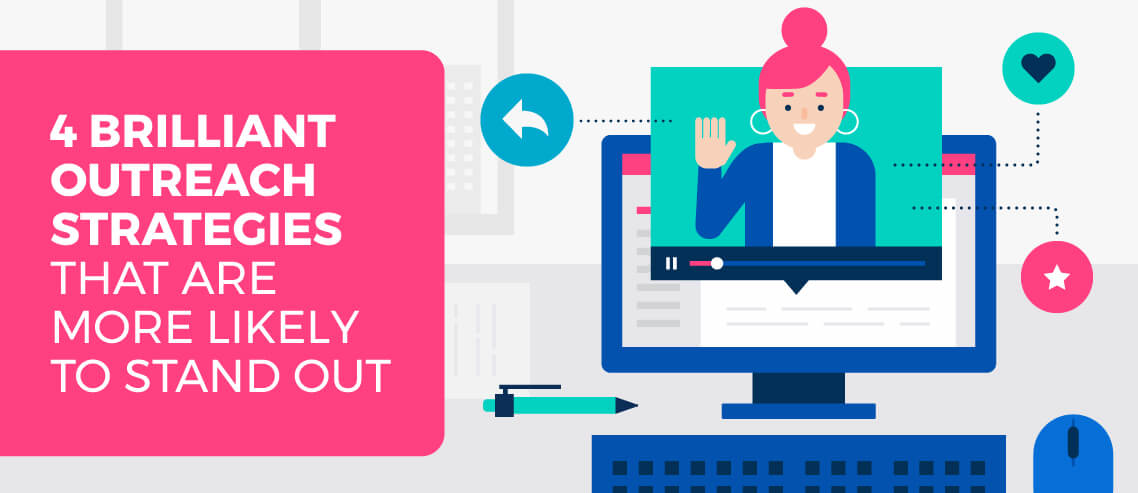5 Indispensable Outreach Lessons from a Master Influencer Marketer

Contents
Jason Quey is an influencer marketer from Spokane, WA.
He helps entrepreneurs connect with influencers so they can rapidly grow their business together.
He’s been featured in Entrepreneur Magazine, Inc, and HuffPo. Also, quoted in Forbes, US News, and SalesForce.
Currently, Quey serves as the VP of Marketing and Operations at Codeless.
When not growing traffic and revenue, Jason considers new business ideas to pursue and tests off-the-wall marketing ideas, such as finding a spouse using Facebook ads and ranking his picture for “best-looking marketer.”
Yes. Those last two are true.

Here are the strategies, tactics, and workflows that Quey uses to get mainstream media placements for clients on a daily basis.
And how you can use the same outreach tactics to grow your business, too.
Lesson #1: Know What Influencer Marketing Is (And Isn’t)
Influencer marketing is one of the most used and abused words out there, according to Quey.
“Influencer marketing is a form of marketing where you identify key people who have influence over your potential buyers,” Quey said.
“Roughly 80% of your results will come from 20% of causes,” he added.

In theory, 20% of people create 80% of the content online. Of the 20% of content creators, only 4% (or 20% of 20%) are creating the most effective content.
Those 4% are the influencers to target.
And the payoff of targeting them can be incredible.
Nielsen Catalina Solutions partnered up with TapInfluence and WhiteWave Foods to release a case study that proves that Influencer Marketing brings in $285 of increased sales for every 1,000 views.
TapInfluence found that this amount is 11 times the ROI in comparison to all other forms of digital media.

For each dollar invested in influencer marketing, businesses make $6.50. While 70% of businesses earn over at least $2 for every $1 that they invest. The top 13% of businesses make $20 or more.
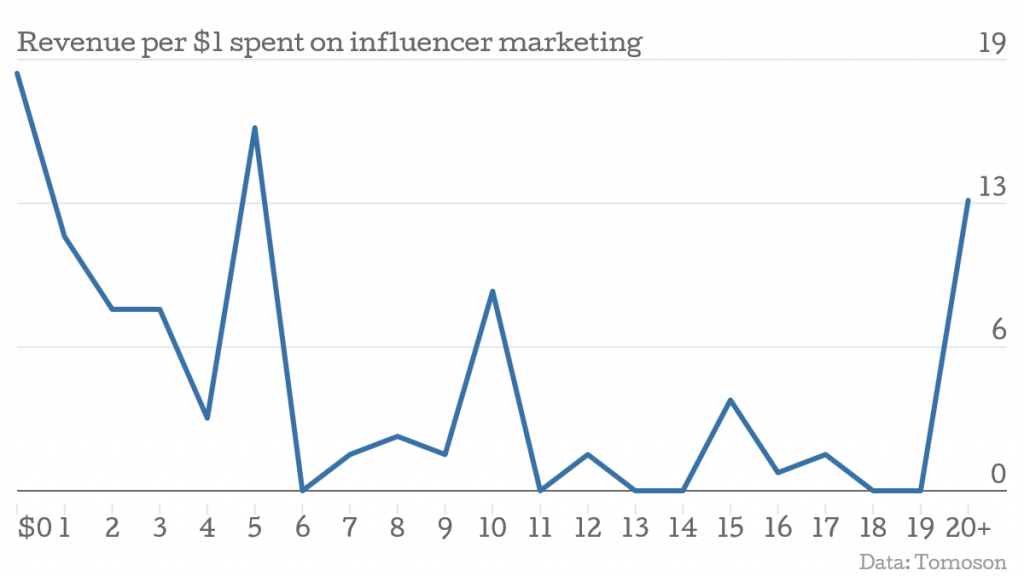
Twitter reported an increase of 5.2x when it comes to purchase-intent when people found content from a company and an influencer rather than just a company alone.

And 49% of those on Twitter say that they make buying decisions based off of recommendations from Twitter influencers.

So you now you know that influencers can help you.
But why would they want to?
Lesson #2: Build real, not spammy, influencer relationships
Influencers have what you need. They have the eyeballs and clout.
But they need something, too.
And that’s your in. Figure out what each wants or needs, and you can often strike a bargain.
Quey’s formula is: Research + Relevance + Reward = Response
If an ask is relevant, the likelihood of success is:
(Relationship Score * Value Given)
______________________________ X Follow-Ups
(Size of Ask * Current Demands)
Quey also says that most people confuse influencers with celebrities. Celebrities are really hard to woo.
You don’t want to start out your influencer marketing journey by trying to get Kim Kardashian to back your product because she probably won’t respond.

There’s a huge difference between the following (and what each wants):
- Celebrities
- Authorities
- PR
- Connectors
- Micro-influencers
For example, influencers might also help you because “you may have a skill they don’t have that they want,” according to Quey.
Foundr used Instagram early on to get big results when it comes to connections. And they did it in a way that no one else had before.

“One way they were able to connect to highly influential people was by teaching celebrity influencers something they wanted to learn, but had not mastered,” Quey said.
Buzzsumo is a similar tool to find influencers across different channels.

With Buzzsumo, you can find influencers in your specific industry by searching for a topic or domain in the search bar.
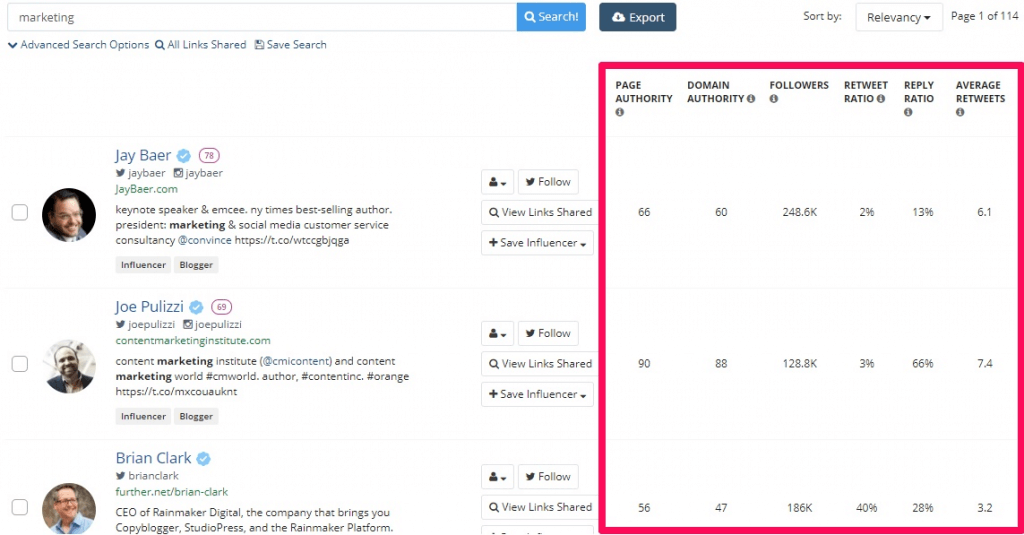
The tool will rank the influencers and give you stats on their number of followers, along with their reply and re-tweet ratios.
That way, you can get a sense of who is a realistic influencer for you to actually reach out to.
And don’t worry about “spamming” them.
We asked Quey, “What would you say to someone who’s hesitant to try influencer marketing because it sounds “spammy” or ‘weird’?”
His response?
“Is building relationships spammy or weird?”
Building relationships is the core of great influencer marketing.
Do that with your initial outreach email, which you can create in Mailshake with ease.

There’s always someone abusing a marketing channel: SEO, “growth hacking,” social media.
“That doesn’t mean it isn’t effective or can’t be done right,” Quey said.
Following up with someone doesn’t have to be spammy either. Typically, it’s the message that is spammy, not the follow-up.
As long as you aren’t talking (writing) like a spammer, you won’t look like one.

Wouldn’t it be nice to be able to keep track of who has responded and who hasn’t without having to go searching through your inbox?
Even better – if you could schedule follow-up emails to the ones who haven’t responded without having to think about it?
With Mailshake, you can also automate replies to send on any given number of days after an initial email is sent.

Lesson #3: Determine the right cadence in advance
Most people think that influencer marketing will solve their business problems.
Or they don’t understand why it’s important.
Or they aren’t willing to deepen the relationship with an influencer.
Or make unreasonable demands too soon.
There’s no shortage of ways to screw this up. Lead with the wrong ask, to the wrong person, at the wrong time, and you burn the bridge before it ever got a shot.
For a campaign to be successful, you have to know why influencer marketing exists, how it can help you, and why you should use it.
And you have to look at it as a long-term partnership with an influencer rather than a short-term interaction.
One technique is to automate campaigns on Mailshake to track opens or link clicks so that you can see how influencers are reacting:

You want to start small. You’re just trying to get a foot in the door initially. Then you can use data like opens and clicks to help you figure out their interest level.
According to Quey, other errors that people make with influencer marketing include:
- Not doing a “1-2 punch.”
- Sending too few emails or no follow-up.
- Sending too many emails.
- Not making an ask or the ask is unclear.
- Thinking that one tactic works for everyone. Example – you need to tweet, comment, etc. everywhere before pitching. I often just pitch.
- Not having a clear goal in mind, short-term and ideally long-term. For example, is your goal getting more traffic to your blog? Building links? Or gaining a connection with a CMO?
- Not quantifying the relationship.
Quey says, “It’s tough because we don’t want to treat someone as a number.”
In some ways, they shouldn’t.
“But that doesn’t mean we can’t gauge where you are in the relationship or their potential impact on your business,” Quey added.

After a campaign is sent with Mailshake, you can tell how many opens, replies, clicks, and bounces your email has received.
That way, you know exactly where each campaign stands.
Here are some tips from Quey you can use to avoid spamming influencers into talking to you.
- Have the right frame of mind. Think of how you build relationships, not as “networking” or “influencer marketing.”
- Always figure out how to do more than what the influencers expect.
- Try to determine why they did not respond or said no. This can give you another angle to make a different ask.
Did they forget? Send a reminder. Often follow up 2-3x, if not more.
In Mailkshake, you can set up a campaign to remind you to follow up if you haven’t heard back yet.

Was the email too long winded?
Were you asking for something too much too early?
Most of us respond best to messages from people we know or at least recognize the name of. That’s why you should interact with recipients in some way before you hit send.
That might mean meeting them in person – say, at a conference or networking event.
Or interacting with them on social media – retweeting them a few times and @ replying to a couple of their tweets, for example.
People have reached out to Sujan Patel on Slack before, and their efforts actually worked.
They essentially got his “soft-agree” to their pitch over the popular messaging app. And you can do the same thing.
Lesson #4. Segment your influencers into cohorts
The number of influencers you reach out to for a post will depend on your industry.
“Try to gauge likelihood based on past results. I’ve asked between 0-100 influencers for a single campaign,” Quey said.
You can schedule out these campaigns in the Mailshake calendar.

Sometimes, smaller groups work best because you can focus more on the results with an influencer.
But Quey says larger works sometimes, too, because you can hit an “inflection point” where other influencers will start to promote it.
“For promoting a real-estate event, I’ve sent emails to over 6K people with 2-3 follow up emails.”
Quey says to keep doing what works and is worth the investment. You never know.

Okay, so an influencer likes your content. How should you make an “ask” of them to help?
Quey says it depends on the context.
What’s your relationship?
How did they come across the content?
Once you’ve figured that out, how should you be following up with influencers without seeming annoying?
Quey says:
- Keep it short
- Don’t make a direct ask in the 1st email (i.e., no links!)
- Try following up on other channels (social)
Quey has done 5-6 follow-ups for certain occasions.
If you’re planning to send out more than just a few emails here and there, you’ll want to save yourself time by using a template.
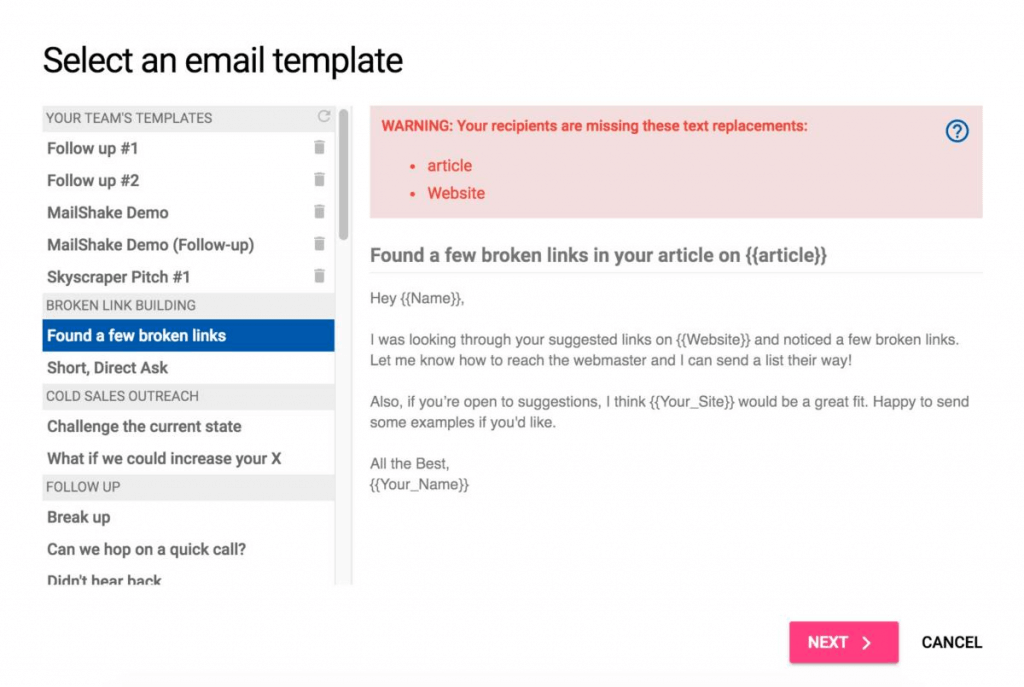
With Mailshake, you can select templates and receive suggestions on how to improve your email within the platform before you hit send.
Working with templates is like starting with a “cheat sheet” for writing emails. They’re proven formulas that have worked in the past and should continue to work.
But you want to choose the templates that don’t look like templates.
And they don’t need to be worded like templates either. Be sure to add your own personality to the email body.
Lesson #5: Don’t Ignore Bounce-Back Emails
If an email bounces back, do you just ignore it and move onto the next candidate?
Depending on your goals, you might not want to.
There are tons of reasons that an email could bounce back into your inbox.
But that doesn’t necessarily mean that you should take a prospect off of your list.
Mailshake easily lets you add in new emails to the same campaign after you launch it, or add new recipients.
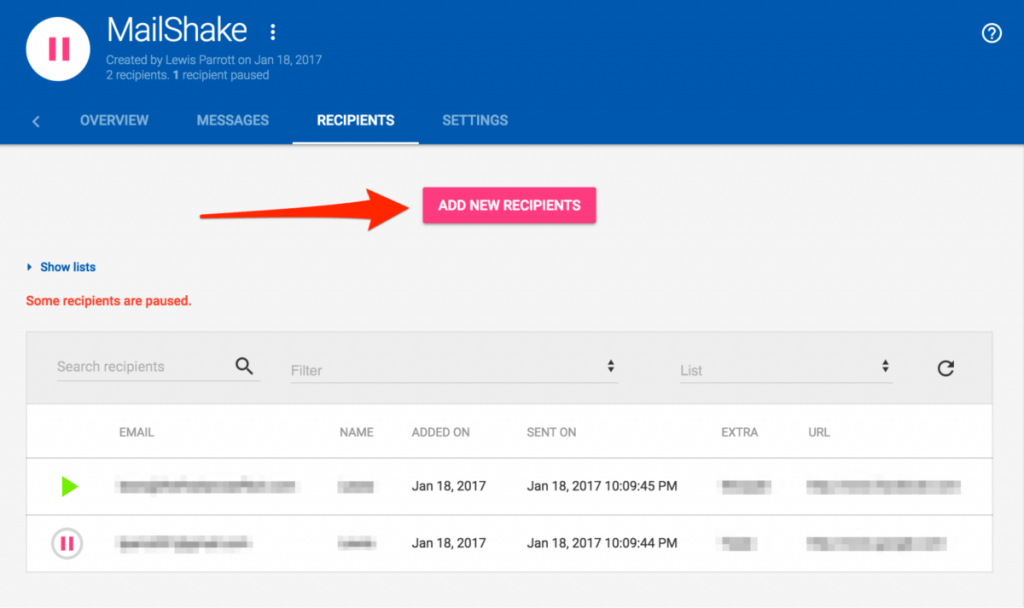
According to Sujan Patel, a few reasons for bounce back emails are:
- The person you contacted doesn’t work there anymore (find a different contact).
- The email address is wrong (double check for typos).
- The recipient’s server is down (try again later).
The trick is to determine which of those three reasons it is and how you should respond accordingly.
Quey says that your success-rate goals will depend on what success is to you.
Are you looking to gain more subscribers? Have fewer email bounces?
Get a higher open rate or response rate?
For open rates, shoot for 30-60%.
A 2017 HubSpot study found that B2B open rates are, on average, around the 30% mark. But B2C open rates are usually anywhere from 30.5% to 34.9%.

For response rates shoot for 10-30%.
Bounces and unsub rates should be less than 2%.
If your numbers are too low, check out Quey’s tips to improve them.
- Low open rates? Change the subject line. Add in their first name, be less formal, or do some more follow-ups.
- Low response rates? Shorten up the email body. Don’t make a direct ask.
- High bounce rates/unsubscribes? Again, don’t ask too much too soon. Ask permission before asking more. Use a good email system, like Mailshake.
Conclusion
Influencer marketing is misunderstood.
If you go about it the right way, you can see massive results.
Do it the wrong way, and you’ll ruin your brand name with just about every bigwig out there who might otherwise help you.
It’s a slippery slope. You can’t afford to make basic errors. Follow these five steps and get more about influencer marketing from Jason at TheStorytellerMarketer.com/influencer-marketing/.
It includes everything he’s ever written on influencer marketing and even includes his entire in-depth influencer outreach plan.
Quey says, “If you sign up, you learn more about influencer marketing, content strategy, and principles of growth. No thoughtless listicles.”


